Mercury is the planet nearest the sun. It has a diameter of 3,032 miles (4,879 kilometers), about two-fifths of Earth’s diameter. Mercury orbits the sun at an average distance of about 36 million miles (58 million kilometers), compared with about 93 million miles (150 million kilometers) for Earth.
Because of Mercury’s size and nearness to the brightly shining sun, the planet is often hard to see from Earth without a telescope. At certain times of the year, Mercury can be seen low in the western sky just after sunset. At other times, it can be seen low in the eastern sky just before sunrise.
Orbit.
Mercury travels around the sun in an elliptical (oval-shaped) orbit. The planet is about 28,580,000 miles (46,000,000 kilometers) from the sun at its closest point, and about 43,380,000 miles (69,820,000 kilometers) from the sun at its farthest point. Mercury is about 48,000,000 miles (77,300,000 kilometers) from Earth at its closest approach. 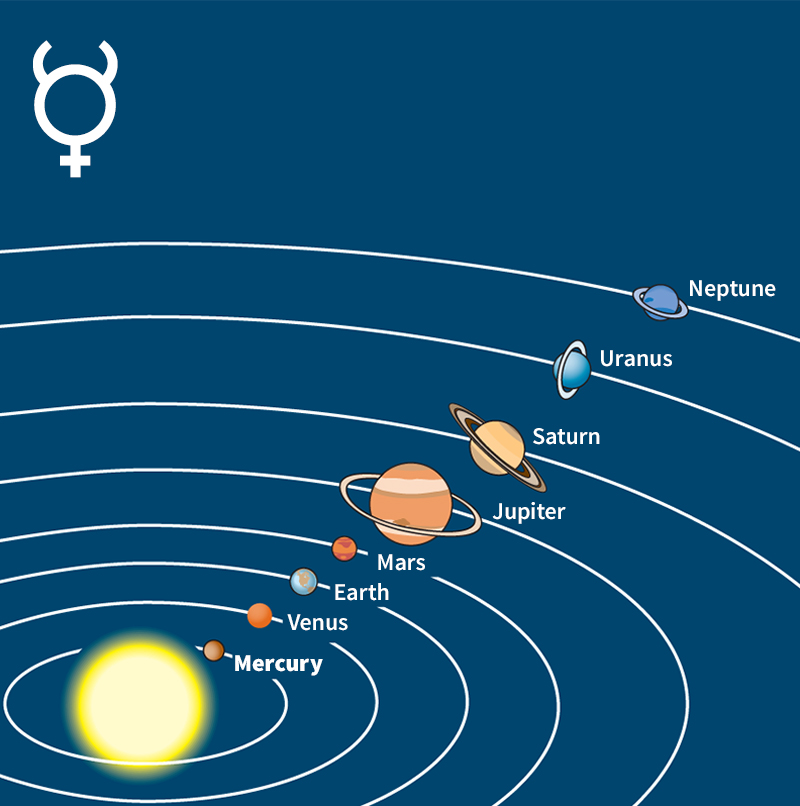
Mercury moves around the sun faster than any other planet. The ancient Romans named it Mercury in honor of the swift messenger of their gods (see Mercury). Mercury travels about 30 miles (48 kilometers) per second, and goes around the sun once every 88 Earth days. Earth goes around the sun once every 365 days, or one year.
Rotation.
As Mercury moves around the sun, it rotates on its axis, an imaginary line that runs through its center. The planet rotates once about every 59 Earth days—a rotation slower than that of any other planet except Venus. As a result of the planet’s slow rotation on its axis and rapid movement around the sun, a day on Mercury—that is, the interval between one sunrise and the next—lasts 176 Earth days.
Until the mid-1960’s, astronomers believed that Mercury rotated once every 88 Earth days, the same time the planet takes to go around the sun. If Mercury did this, one side of the planet would always face the sun, and the other side would always be dark. However, radar studies conducted in 1965 showed that the planet rotates once in about 59 days.
Phases.
When viewed through a telescope, Mercury can be seen going through “changes” in shape and size. These apparent changes are called phases, and resemble those of the moon. They result from different parts of Mercury’s sunlit side being visible from Earth at different times. 
As Mercury and Earth travel around the sun, Mercury can be seen near the other side of the sun about every 116 days. At this point, almost all its sunlit area is visible from Earth. It looks like a bright, round spot with almost no visible marks. As Mercury moves around the sun toward Earth, less and less of its sunlit area can be seen. After about 36 days, only half its surface is visible. After another 22 days, it nears the same side of the sun as Earth, and only a thin sunlit area is visible. The amount of sunlit area that can be seen increases gradually after Mercury passes in front of the sun and begins moving away from Earth.
When Mercury is on the same side of the sun as Earth is, its dark side faces Earth. The planet is usually not visible at this point because Mercury and Earth orbit the sun at different angles. As a result, Mercury does not always pass directly between Earth and the sun. Sometimes Mercury is directly between Earth and the sun. When this occurs, every 3 to 13 years, the planet is in transit and can be seen as a black spot against the sun.
Surface and atmosphere.
Mercury’s surface appears to be much like that of the moon. It reflects approximately 6 percent of the sunlight it receives, about the same as the moon’s surface reflects. Like the moon, Mercury is covered by a thin layer of minerals called silicates in the form of tiny particles. It also has broad, flat plains; steep cliffs; and many deep craters similar to those on the moon. The craters formed when meteors or small comets crashed into the planet. Mercury does not have enough atmosphere to slow down meteoroids and burn them up by friction. The Caloris Basin, Mercury’s largest crater, measures about 800 miles (1,300 kilometers) across.
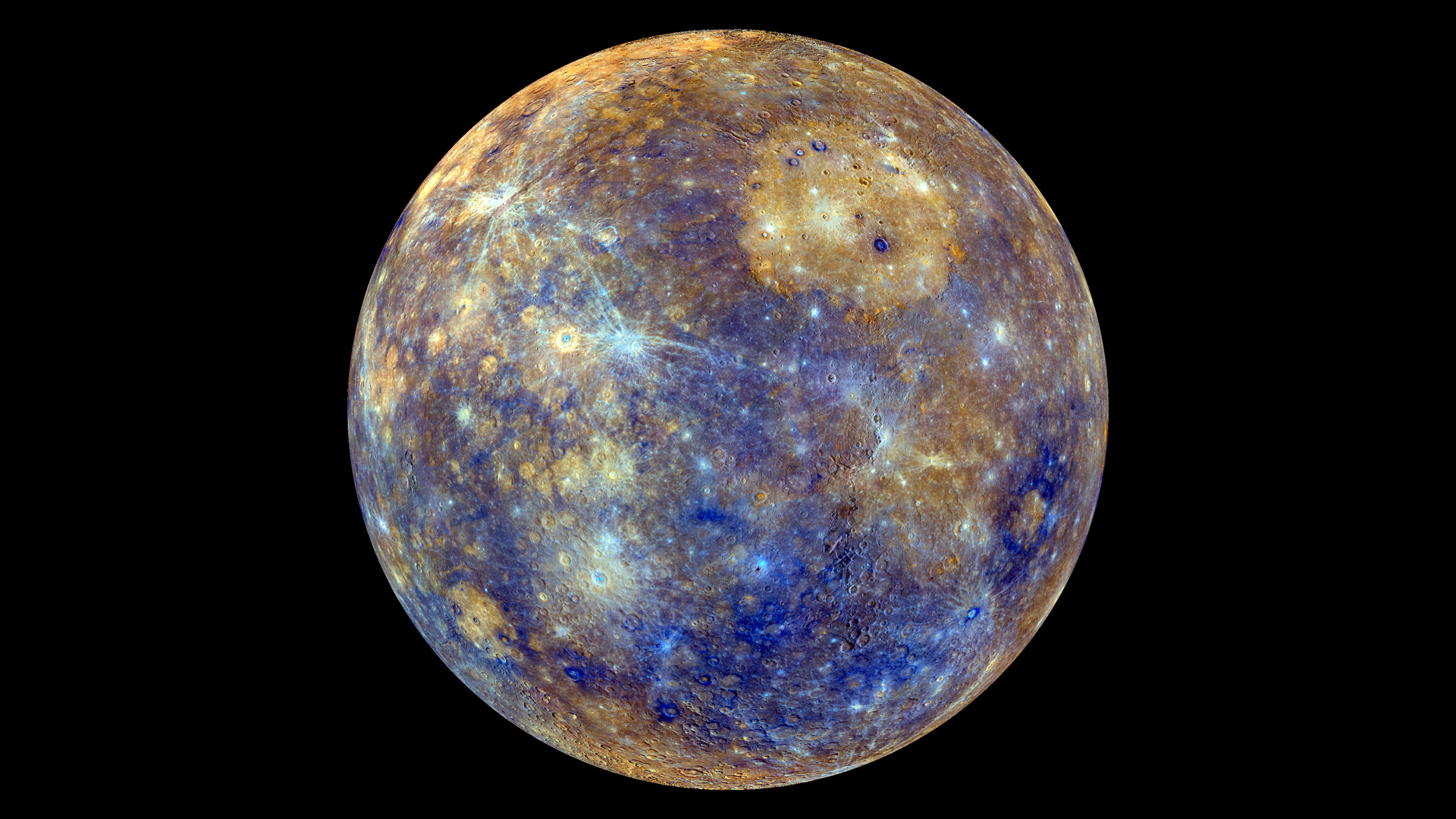
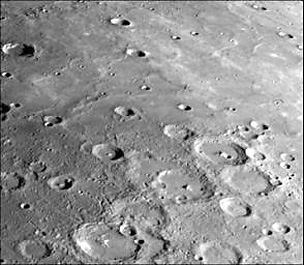
Mercury’s interior appears to resemble that of Earth. Both planets have a rocky layer called a mantle beneath their crust, and both planets have an iron core. Scientists think that Mercury’s core extends to between two-thirds and three-fourths of the planet’s radius. Earth’s core, for comparison, extends to about half of Earth’s radius. Mercury has a fluid outer core made of iron and some lighter elements. The movement of Mercury’s fluid outer core produces a magnetic field, just as the movement of Earth’s outer core does. However, Mercury’s magnetic field is tilted about 20 degrees from the planet’s axis of rotation, about twice as far as that of Earth.
Mercury is dry, extremely hot, and almost airless. The sun’s rays are approximately seven times as strong on Mercury as they are on Earth. The sun also appears about 21/2 times as large in Mercury’s sky as in Earth’s.
Mercury does not have enough gases in its atmosphere to reduce the amount of heat and light it receives from the sun. The temperature on the planet may reach 840 °F (450 °C) during the day. But at night, the temperature may drop as low as –275 °F (–170 °C). Because of the lack of atmosphere, Mercury’s sky is black. Stars probably would be visible from the surface during the day.
Scans of Mercury made by Earth-based radar indicate that craters at Mercury’s poles contain water ice. The floors of the craters are permanently shielded from sunlight, so the temperature never gets high enough to melt the ice.
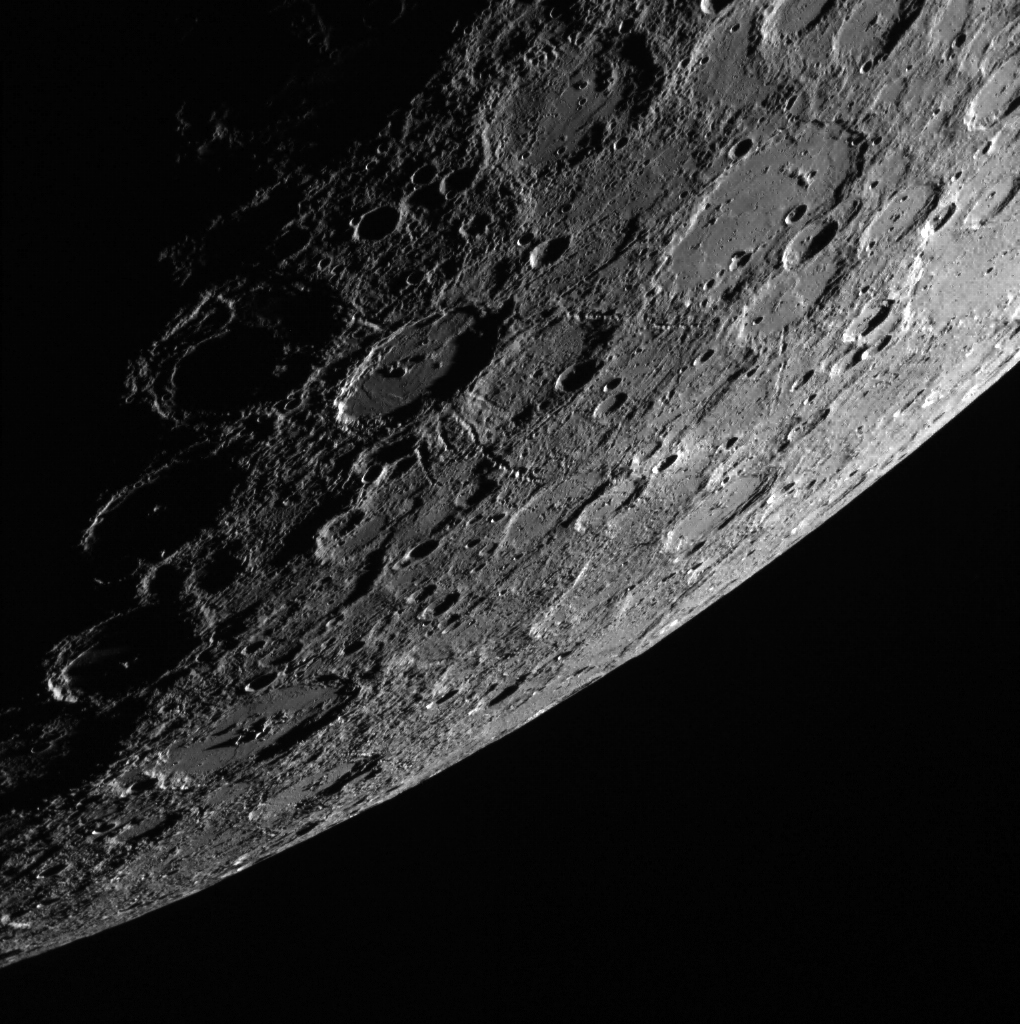
Mercury is surrounded by an extremely small amount of calcium, helium, hydrogen, magnesium, oxygen, potassium, silicon, sodium, and water vapor. This envelope of gases is so thin that the greatest possible atmospheric pressure (force exerted by the weight of gases) on Mercury would be about 0.00000000003 pound per square inch (0.000000000002 kilogram per square centimeter). The atmospheric pressure on the Earth is about 14.7 pounds per square inch (1.03 kilograms per square centimeter).
The plant and animal life of Earth could not live on Mercury because of the lack of oxygen and the intense heat. Scientists doubt that the planet has any form of life.
Density and mass.
Mercury’s density is slightly less than Earth’s (see Density). That is, a portion of Mercury would weigh slightly less than an equal portion of Earth. Mercury is smaller than Earth and therefore has much less mass (see Mass). Mercury’s smaller mass makes its force of gravity only about a third as strong as that of Earth. An object that weighs 100 pounds (45 kilograms) on the Earth would weigh only about 38 pounds on Mercury (the equivalent of about 17 kilograms on Earth).
Flights to Mercury.
The United States Mariner 10 became the first spacecraft to reach Mercury. The remotely controlled spacecraft flew to within 460 miles (740 kilometers) of Mercury on March 29, 1974. It swept past the planet again on Sept. 24, 1974, and on March 16, 1975. During those flights, the spacecraft photographed portions of the surface of Mercury. It also detected Mercury’s magnetic field.
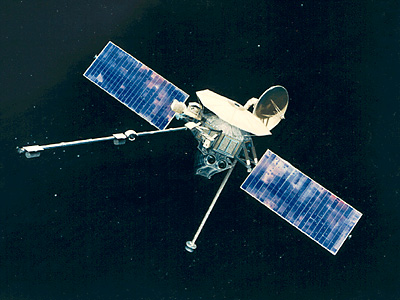
Mariner 10 was the first spacecraft to study two planets. The probe photographed and made scientific measurements of Venus while traveling to Mercury. It was also the first spacecraft to use a gravity assist. As the probe flew past Venus, the planet’s gravity pulled on the spacecraft. The pull of gravity bent the spacecraft’s trajectory (path through space), sending it toward Mercury. The maneuver enabled Mariner 10 to reach Mercury in less time and by using less fuel than if it had flown directly from Earth.
In 2004, the United States launched the MESSENGER (Mercury Surface, Space Environment, Geochemistry, and Ranging) probe to Mercury. In 2008 and 2009, the craft flew by Mercury and photographed areas of its surface that had never been seen by a spacecraft. MESSENGER went into orbit around the planet in March 2011. The probe mapped Mercury’s surface and studied its composition, interior structure, and magnetic field. In 2015, the probe ran out of fuel and crashed into Mercury. 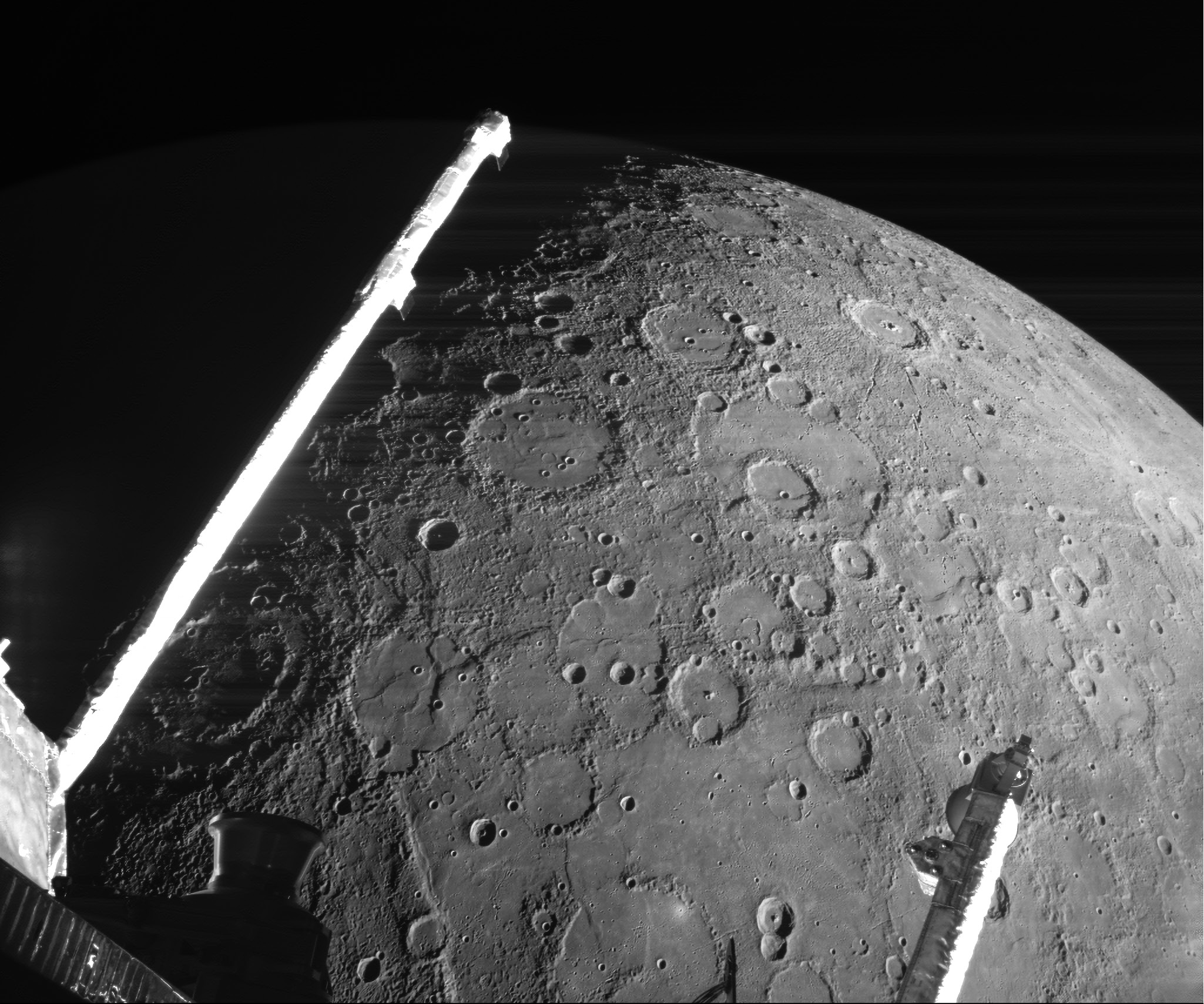
The third Mercury mission, BepiColombo, launched in 2018. BepiColombo is a mission of Europe and Japan. Its two probes travel, connected, as one spacecraft. This spacecraft orbits the sun in a trajectory that repeatedly carries it past Mercury. During these flybys, the spacecraft takes photographs and collects data. But its main science mission is set to begin in 2026. In late 2025, the two probes will separate and enter orbit around Mercury. One carries instruments to study Mercury’s magnetic field and the environment around the planet. The other will study the planet’s surface and interior.
